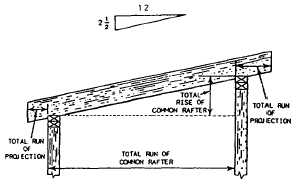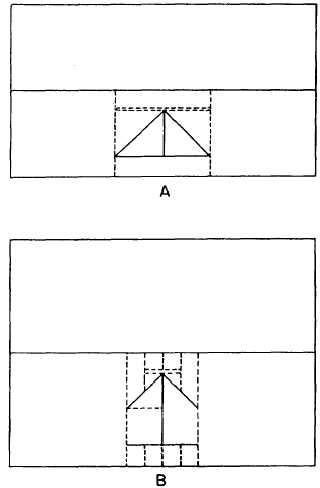Figure 2-56.-Lengths of dormer ridge.
main-roof ridge. The shortening allowance amounts to
one-half the thickness of the main-roof ridge.
View B shows that the length of the ridge for an
unequal-span addition varies with the method of
framing the ridge. If the addition ridge is suspended
from the main-roof ridge, the length is equal to the
length of the addition top plate, plus one-half the span
of the building. If the addition ridge is framed by the
long and short valley rafter method, the length is equal
to the length of the addition top plate, plus one-half the
span of the addition, minus a shortening allowance
one-half the 45° thickness of the long valley rafter. If the
addition ridge is framed to a double header set between
a couple of double main-roof common rafters, the length
of the ridge is equal to the length of the addition sidewall
rafter plate, plus one-half the span of the addition, minus
a shortening allowance one-half the
inside member of the double header.
thickness of the
the
2-34
Figure 2-57.-Shed roof framing.
Figure 2-56, view A, shows that the length of the
ridge on a dormer without sidewalls is equal to one-half
the span of the dormer, less a shortening allowance
one-half the thickness of the inside member of the upper
double header. View B shows that the length of the ridge
on a dormer with sidewalls is the length of the dormer
rafter plate, plus one-half the span of the dormer, minus
a shortening allowance one-half the thickness of the
inside member of the upper double header.
SHED
A shed roof is essentially one-half of a gable roof.
Like the full-length rafters in a gable roof, the full-length
rafters in a shed roof are common rafters. However, the
total run of a shed roof common rafter is equal to the
span of the building minus the width of the top plate on
the higher rafter-end wall (fig. 2-57). Also, the run of
the overhang on the higher wall is measured from the
inner edge of the top plate. With these exceptions, shed
roof common rafters are laid out like gable roof common
rafters. A shed roof common rafter has two bird’s-
mouths, but they are laid out just like the bird’s-mouth
on a gable roof common rafter.
For a shed roof, the height of the higher rafter-end
wall must exceed the height of the lower by an amount
equal to the total rise of a common rafter.
Figure 2-58 shows a method of framing a shed
dormer. This type of dormer can be installed on almost
any type of roof. There are three layout problems to be
solved here: determining the total run of a dormer rafter;
determining the angle of cut on the inboard ends of the
dormer rafters; and determining the lengths of the
dormer sidewall studs.
To determine the total run of a dormer rafter, divide
height of the dormer end wall, in inches, by the




